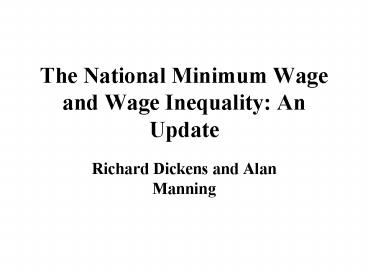The National Minimum Wage and Wage Inequality: An Update - PowerPoint PPT Presentation
1 / 25
Title:
The National Minimum Wage and Wage Inequality: An Update
Description:
Used to it always getting worse but bottom-end wage inequality has been ... Estimate probit model for whether hourly rate observed ... – PowerPoint PPT presentation
Number of Views:156
Avg rating:3.0/5.0
Title: The National Minimum Wage and Wage Inequality: An Update
1
The National Minimum Wage and Wage Inequality An
Update
- Richard Dickens and Alan Manning
2
Why is an update needed?
- Some interesting things have been happening to
wage inequality in the UK - Used to it always getting worse but bottom-end
wage inequality has been declining for some
considerable time - Tempting to put this down to the NMW
- But perhaps not all of it
3
Recent Trends in UK Wage Inequality
4
Where in distribution is change happening?
5
Change up to 25th percentile
6
What Could Be Going On Here?
- Impact of Minimum wage from 1999
- Other factors causing changes in wage inequality
- Strong labour market
- Rise in educational attainment
- Lovely vs. lousy jobs
- Immigration
7
Our Earlier Findings on Impact of NMW
- Dickens and Manning (JRSS, 2004)
- Used LFS
- Found effect of NMW and zero spill-over
- No effect on 10th percentile, only on 5th
- Dickens and Manning (EJ, 2004)
- Care homes data
- Minimum wage much more important (40 affected)
- Still no spill-over effect
- Reduction in wage inequality seems much larger
than we would expect from these results - Contrast with US
- Lee (QJE, 1998) implies quite large spill-overs
8
What might be happening?
- NMW has been increasing faster than median
earnings - NMW has spill-over effects over long period
earlier studies were impact effect - Measurement Error Problems
- Other factors at work
9
The Kaitz Index(NMW/Median Hourly Earnings)
10
But Measures of Spike Do Not Seem To Show Big
Increase
11
Relationship between Kaitz Index and Spike
12
Other estimates of spike
- ONS only seems to provide estimates of those paid
below the NMW based on ASHE - More or less in line with LFS
- LPC Report suggests 3.2 were beneficiaries of
Oct 05 increase - Cant seem to explain powerful reduction in wage
inequality.
13
Measurement Error Problems
- Would expect the pattern we see a simple
example - Underlying wage dist log normal
- Perfect compliance with minimum wage approx 5
affected - But observed wage distribution true classical
error
14
What Would We See?
15
Can Use Hourly Rate Measure
- LFS has collected hourly rate since March 1999
- Only available for 38 of people
- Have to impute for others
- ONS and Dickens/Manning describe methodologies
for doing this
16
Propensity Score Re-weighting
- Assumption conditional on covariates, the
distribution of hourly rate is independent of
whether it is observed or not - Estimate probit model for whether hourly rate
observed - A strong assumption probably leads to
over-estimate of impact of NMW
17
Details
- Hourly rate only collected from March 1999 i.e.
only one month prior to NMW - Routing of question then different from
subsequently - We will compare 2001q1 with 2006q1 (2001q1 NMW
low in real terms)
18
Comparison of Changes in Hourly Rate and Hourly
Pay Measures
19
- Changes reach too far up wage distribution to be
direct effect of NMW - Do not seem able to explain them by measurement
problems - What about spill-overs?
20
The Lee Model of Spill-Overs
- Latent log wage distribution w(F) assume
normal - Only direct effect of NMW
- Lee adds possibility of spill-over
- Spill-over parameter ß high value, big
spill-over - This model works well
21
Estimate Lee Model for 2001q1-2006q1
22
Goodness-of-fit for 2006q1
23
Implied Impact of NMW on Average Log Hourly Wages
24
Conclusions
- Fall in wage inequality can be explained using
direct effect of NMW and modest spill-over effect - Implies other factors not so important
- Can this really be true?
25
The Impact of Immigration

